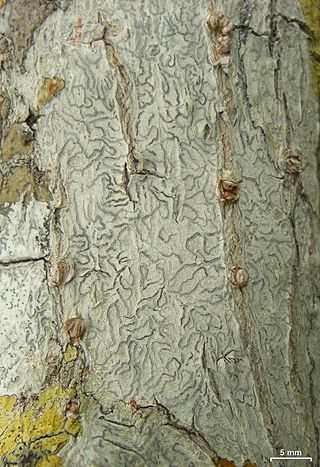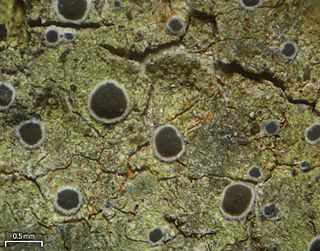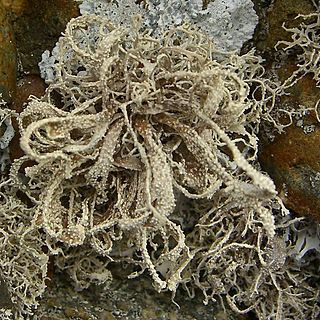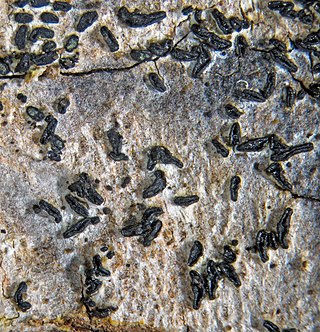
The Roccellaceae are a family of mostly lichen-forming fungi in the order Arthoniales, circumscribed by the French botanist François Fulgis Chevallier in 1826. Species in the family exhibit various growth forms, including crustose and fruticose thalli, and diverse reproductive structures. Roccellaceae species typically have apotheciate or lirellate ascomata, often with distinct blackened margins. Molecular phylogenetics studies have revealed significant genetic diversity and complex evolutionary histories within the family.

Platygramme is a genus of lichen-forming fungi in the family Graphidaceae consisting of about 30 species. The genus was circumscribed by Antoine Laurent Apollinaire Fée in 1874.

Byssoloma is a genus of leaf-dwelling lichens in the family Pilocarpaceae.
Sporopodium is a genus of lichen-forming fungi in the family Pilocarpaceae.

Cryptothecia is a genus of white to greenish crustose lichens that grow on bark, wood, or leaves, in tropical or subtropical areas worldwide. It has a conspicuous prothallus that develops around its periphery which can be bright red in some species, hence the common name wreath lichen. The main vegetative body (thallus) lacks a cortex (ecorticate and is often immersed in the substrate or byssoid. The medulla is white, well defined, and often peppered with calcium oxalate crystals. Ascomata are not well defined, being cushions of soft white mycelium immersed in the medullary tissue, hence the name from the Greek krypto = "to conceal" and theke = "a container or sheath". It contains Trentepohlia, a green alga, as its photobiont partner.

Dendrographa is a genus of lichen-forming fungi in the family Roccellaceae. It has seven species. It was given its current name by Otto Vernon Darbishire in 1895.

Cresponea is a genus of lichens in the family Opegraphaceae. The genus, circumscribed in 1993, contains species that were formerly classified in Lecanactis. Cresponea is widely distributed, but most species are found in tropical and subtropical regions. The genus is named in honor of Spanish lichenologist Ana Crespo.

Enterographa is a genus of lichens in the family Roccellaceae.

Mazosia is a genus of lichen-forming fungi in the family Roccellaceae. The genus was circumscribed by Italian lichenologist Abramo Bartolommeo Massalongo in 1854.

Lecanactis is a genus of crustose lichens, commonly called old wood rimmed lichen. The genus was circumscribed in 1855 by German lichenologist Gustav Wilhelm Körber, who assigned Lecanactis abietina as the type species.
Synarthonia is a genus of lichen-forming fungi in the order Arthoniales. The genus has not been placed into a family. Synarthonia was circumscribed by Swiss lichenologist Johannes Müller Argoviensis in 1891.

Chrysothrix is a genus of lichen-forming fungi in the family Chrysotrichaceae. They are commonly called gold dust lichens or sulfur dust lichens, because they are bright yellow to greenish-yellow, sometimes flecked with orange, and composed entirely of powdery soredia. Apothecia are never present in North American specimens.

Malmidea is a genus of crustose lichens and the type genus of the family Malmideaceae. It was established in 2011 to contain a phylogenetically distinct group of species formerly placed in the genus Malcolmiella. The crust-like thallus of Malmidea lichens has a surface that varies from smooth to rough, featuring textures such as verrucose (wart-like), granulose (grainy), or pustulate (pimpled). These textures are often formed by goniocysts, which are spherical clusters of green algal cells from the family Chlorococcaceae, encased in fungal hyphae. Malmidea comprises nearly 70 mostly tropical species that grow on bark, although a few grow on leaves.

Alyxoria is a genus of lichen-forming fungi in the family Lecanographaceae.

Herpothallon is a genus of crustose lichens in the family Arthoniaceae. It has about 50 species.
Myriostigma is a genus of lichens in the family Arthoniaceae. The genus was circumscribed by German lichenologist August von Krempelhuber in 1874.
Gyrographa is a genus of lichen-forming fungi in the family Roccellaceae. The genus was circumscribed in 2014 by Damien Ernst and Anders Tehler, with Gyrographa gyrocarpa assigned as the type species. This lichen, originally described by Julius von Flotow in 1825, was first placed in the genus Opegrapha. Species in the genus have a crustose thallus lacking a cortex, and a dark brown prothallus. The photobiont partner is trentepholioid. The hypothecium is thick and carbonised, and the ascospores lack a gelatinous sheath; these characteristics distinguish it from Opegrapha species. The genus name alludes to the gyrose ascomata of the type species.

Coniocarpon is a genus of lichen-forming fungi in the family Arthoniaceae. It has eight species of corticolous (bark-dwelling) lichens. This genus is distinct for its crystalline orange, red, and purple quinoid pigments in the ascomata that turn purple in potassium hydroxide solution, its colourless, transversely septate ascospores with large apical cells, and its rounded to lirellate ascomata.














